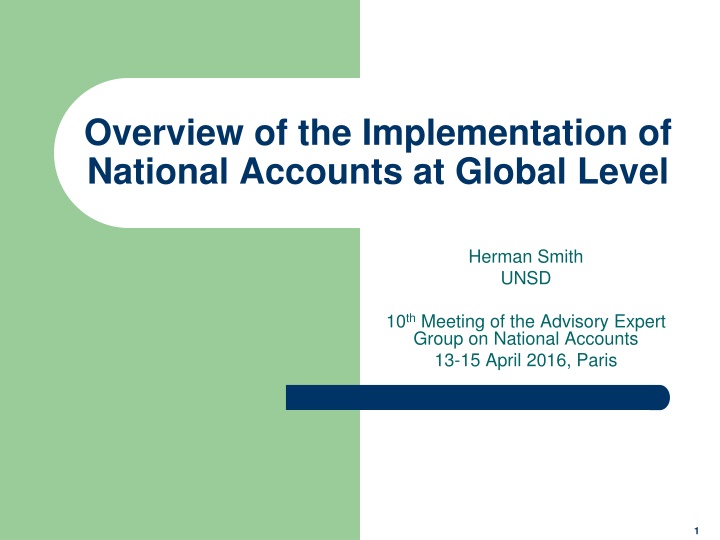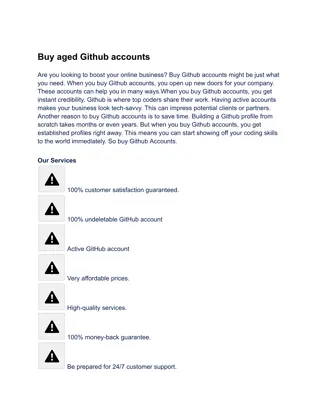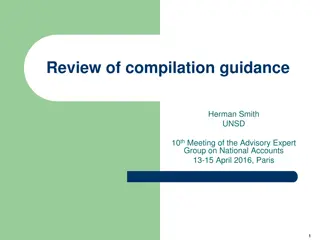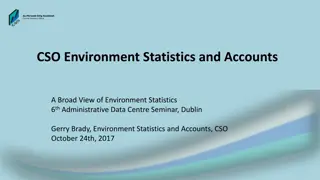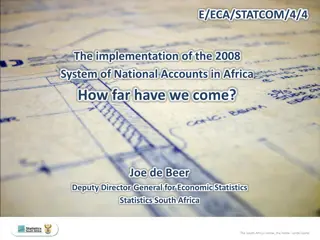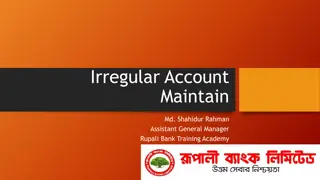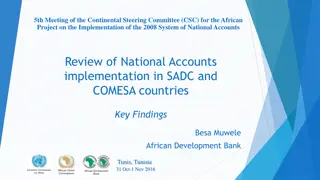Overview of the Implementation of National Accounts at Global Level
This article discusses the progress and challenges in implementing national accounts globally, focusing on the status, monitoring, scope, compliance measures, and annual reporting based on the 2008 System of National Accounts (SNA).
Download Presentation

Please find below an Image/Link to download the presentation.
The content on the website is provided AS IS for your information and personal use only. It may not be sold, licensed, or shared on other websites without obtaining consent from the author.If you encounter any issues during the download, it is possible that the publisher has removed the file from their server.
You are allowed to download the files provided on this website for personal or commercial use, subject to the condition that they are used lawfully. All files are the property of their respective owners.
The content on the website is provided AS IS for your information and personal use only. It may not be sold, licensed, or shared on other websites without obtaining consent from the author.
E N D
Presentation Transcript
Overview of the Implementation of National Accounts at Global Level Herman Smith UNSD 10thMeeting of the Advisory Expert Group on National Accounts 13-15 April 2016, Paris 1
Outline 1. Overview of the status of implementation of the 2008 SNA at global and regional level 2. Global implementation programme of the 2008 SNA 3. Ongoing discussion on the SNA research agenda 2
Status of implementation of the 2008 SNA The implementation of the 2008 SNA is assessed in terms of: Scope Detail Quality Compliance 3
Implementation monitoring For monitoring the implementation of the 1993 SNA the ISWGNA developed a set of six milestones to assess the scope of accounts that are compiled by countries. These milestones were later supplemented by three data sets describing (a) minimum set of accounts that need to be compiled; (b) a recommended set of accounts; and (c) a desired set of accounts. The quality of the national accounts dimension was assessed using the IMF quality assessment framework. To assess the compliance with major 1993 SNA concepts the ISWGNA developed a set of questions. 4
Scope and Compliance Measures for the 2008 SNA The elements of the scope and compliance measures used for the 1993 SNA were deemed to be adequate to also assess the scope and compliance for the 2008 SNA. However, the need for more timely information to facilitate appropriate policy responses highlights the importance to include also the compilation of quarterly national accounts, which require some adjustments to the scope measure as reflected by the required data set measure. The compliance questionnaire was adjusted to reflect the 2008 SNA concepts for determining the conceptual adherence to the 2008 SNA. 5
Global status of annual reporting Almost all countries are reporting annual national accounts to UNSD, many countries with a time lag of more than one year. Most countries currently compliant with the 1993 SNA and ISIC Rev. 3.1, with some countries using the 1968 SNA . Many countries are not able to submit the minimum requirement data set (as defined by the UNSC) to the UNSD. 6
Number of countries reporting annually for the reporting period 2003 to 2014 180 160 140 120 Number of responses 100 80 60 40 20 0 2003 2004 2005 2006 2007 2008 2009 2010 2011 2012 2013 2014 NAQ reporting period 7
Number of countries reporting annually and data availability Number of countries that replied to the UN-NAQ Total number of countries 2014 data available At least once between 2010-2014 NAQ 2013 NAQ 2014 UN Member States Developed region Developing region 193 183 (95%) 165 166 119 (62%) 46 46 (100%) 45 45 40 (87%) 147 137 (93%) 120 121 79 (54%) 8
Reporting of Expenditure based GDP Reporting of quarterly data 2005 2015 Current prices and volume measures 0 75 Reporting of annual data 2005 2015 109 164 Current price 93 145 Constant price Availability of annual data 2004 2014 46 105 Current price 40 96 Constant price 9
Number of countries reporting annually and data availability 193 193 193 180 160 165 166 Total number of Member States 166 140 120 119 NAQs submitted 111 100 107 80 Data for latest reference year available 60 40 20 0 NAQ 2012 NAQ 2013 NAQ 2014
Breakdown of base years 90 80 79 70 60 Number 50 51 40 30 31 27 20 10 5 0 2014-2009, and CPPY 2008-2005 2004-2000 Prior to 1999 No information Base Years 11
Number of countries compliant with the 1968, 1993 and 2008 SNA Total number of countries 1968 SNA compliant 1993 SNA compliant 2008 SNA compliant UN Member States Developed region Developing region 22 109 62 193 - 7 37 46 22 100 25 147 62 Member States have implemented the 2008 SNA Some Member States have opted to introduce certain aspects of 2008 SNA in a gradual implementation of the 2008 SNA 12% of Member States still use 1968 SNA 83 Member States are implementing or partially implementing ISIC Rev. 4
Scope of National Accounts Milestone 1.GDP by Industry and Expenditure in current and volumes Growth analysis Milestone 2. GNI of Total Economy and Balance of Payments (current, capital and financial accounts) and GFS transaction accounts Relations with the rest of the world (BoP) analysis Milestone 3. For all institutional sectors: Production acc. For GG: Generation of income; allocation of primary income; secondary distribution of income, use of disposable income; capital and financial accounts Productivity analysis and fiscal analysis Milestone 4. For all institutional sectors: generation of income, allocation of primary income; secondary distribution of income, use of disposable income; capital and financial accounts Income distribution analysis 13
Milestone 5. Production, income and use accounts, capital accounts and financial accounts for institutional sectors Growth analysis, BOP analysis, productivity analysis, fiscal, income distribution analysis and investment-financing analysis Milestone 6. All transaction and flows accounts plus balance sheets Financing-debt analysis (Flow of funds) and vulnerability analysis (currency mismatches, maturity mismatches (roll- over of debt), capital structure (equity vs debt), solvency (assets over liabilities) 14
Milestones and MRDS The detail of National Accounts is measured in term of Minimum Required Data Set (MRDS) MRDS covers: Milestone 1.GDP by Industry and Expenditure in current and constant prices Milestone 2. GNI of Total Economy and Balance of Payments (current, capital and financial accounts) and GFS transaction accounts Milestone 3. For all institutional sectors: Production acc. For GG: Generation of income; allocation of primary income; secondary distribution of income, use of disposable income; capital and financial accounts Milestone 4. For all institutional sectors: generation of income, allocation of primary income; secondary distribution of income, use of disposable income; capital and financial accounts Minimum required macroeconomic data set, annual institutional sector accounts up to net lending and also quarterly GDP and quarterly BoP 15
National Accounts Questionnaire Tables Table 1.1 1.3 - GDP by expenditure at current/constant prices - Relations among product, income, savings and net lending aggregates at current prices Table 2.1 2.3 - Value added by industries at current/constant prices - Output, GVA and fixed assets by industries at current prices Table 3.1 3.2 - GFCE by function at current prices - Individual CE of HH, NPISHs, and GG at current prices Table 4.1 4.9 - Total Economy (S.1) at current prices - Rest of the world (S.2) at current prices - Non-financial Corporations (S.11) at current prices - Table 5.1 - Cross classification of Gross value added by industries and institutional sectors at current prices MRDS 16
Number of countries submitting the tables of the MRDS GDPe C 1.1 GDPe K 1.2 GDPp C 2.1(2.4) GDPp K 2.2(2.5) GDPp detail 2.3(2.6) IEA Total 1.3(4.1) IEA RoW 4.2 UN Member States Developed region Developing region 176 155 185 180 144 164 110 193 45 44 46 45 45 43 38 46 131 111 139 135 99 118 72 147
Scope of National Accounts Statistics Total number of countries MRDS Milestone Level 6 or more tables 7 tables 1 or higher 2 UN Member States Developed region Developing region 131 (68%) 101 (52%) 176 (91%) 157 (81%) 193 42 (91%) 37 (80%) 45 (98%) 43 (93%) 46 89 (61%) 64 (44%) 131 (89%) 114 (78%) 147 18
Percentage of countries submitting the MRDS 100 Percentage of countries submitting 96 90 93 91 80 83 80 70 75 60 57 MRDS 50 40 30 20 10 0 Table 1.1Table 1.2 Table 2.1/2.4 UN Member States Table 2.2/2.5 Table 2.3/2.6 Table 1.3/4.1 Table 4.2
Implementation Programme for the System of National Accounts 2008 and Supporting Statistics Global initiative to assist countries in developing statistical and institutional capacity to: a) make the conceptual changeover from the 1968 or 1993 SNA to the 2008 SNA and b) improve the scope, detail and quality of national accounts and supporting economic statistics Based on agreed principles of the implementation strategy: Strategic planning Coordination, monitoring and reporting Improving statistical systems 20
This is operationalized through 4 elements: (a) A strategic planning framework - the use of priority-setting national strategies for the development of statistics or similar national plans (b) Information structure based on the integrated economic statistics approach (standards, statistical production process, institutional arrangements) and internationally agreed scope (MRDS) and compliance for the national accounts and supporting economic statistics Modalities of statistical capacity-building: training and technical cooperation, publication of manuals and handbooks, research and advocacy (d) Stages of implementation leading to the changeover to the 2008 SNA: Review, Adaptation and Application (c) 21
Strategic planning framework Global Strategic plan Regional plan National Plan Global strategy Plans are in line with global strategy e.g. NSDS 22
Information structure Integrated statistical systems Modernization of statistical systems Internationally agreed scope (Milestones), detail (MRDS), quality (DQAF) and compliance of the National Accounts 23
Integrated statistics Scope of the statistics programme goes beyond the production of national accounts to also cover the statistical production process of basic statistics and to aspects of the institutional environment It is, thus, based on an integrated statistics approach which Produces statistics that present a consistent and coherent picture of economic activities for policy, business and other analytical uses Uses common concepts, definitions, estimation methods and data sources for statistical reconciliation Moves away from a narrow stove-pipe statistical production model to cross-functional holistic model 24
Integrated statistics Building blocks Common conceptual framework provided by the SNA Institutional arrangements (legislative, organizational, budgetary, managerial and customer relationship arrangements) further support the environment for integration Statistical production process as an integrated production chain from the collection of basic data to the dissemination of statistics 25
Integrated statistics approach Silo approach Integrated statistics Agency A Agency B Agency C Indicators Policy A Policy B Policy C Accounts SNA and SEEA Info A Info B Info C Basic data Data A Data B Data C Economy Environment Social Accounts to integrate statistics: Linking policy needs and statistics Understanding the institutional arrangements Integrated statistical production process/chain and services Consistency between basic data, accounts and tables and indicators 26
Integrated statistics approach Dissemination Macroeconomic accounts Outputs / Household and demographic statistics Economic & environmental statistics Statistical operations Data integration Inputs Data processing Data collection Registers and frames Surveys Statistical infrastructure Standards and methods Information, Communication Technology (ICT) Institutional setting Management and internal policy Institutional arrangements 27
Modalities of statistical capacity-building Training and technical cooperation Publication of manuals and handbooks Research Advocacy 28
Publication of manuals and handbooks Information on completed publications is available online at: http://unstats.un.org/unsd/nationalaccount/pubsDB.asp?pType=2 29
Research Advance the research agenda to provide further guidance on Practical issues encountered in the implementation of the 2008 SNA Methodological improvements to better measure existing and emerging economic realities ISWGNA revise and update the SNA and develop supporting normative international statistical standards and other methodological documents on national accounts and supporting statistics Advisory Expert Group (AEG) on National Accounts to resolve issues on the research agenda of the SNA and to review documents and tools for the SNA implementation. 30
Research Agenda Issues Under Discussion are available at: http://unstats.un.org/unsd/nationalaccount/UnderDiscussion.asp 31
Advocacy To support an ongoing dialogue among statistical producers, the various levels of government, business sector, the academic community, and the general public about user needs for official statistics and the progress in meeting those needs the role of official statistics in evidenced based decision and policy making 32
Stages of implementation leading to the changeover to the 2008 SNA Review of strategic framework and detailing of national and regional implementation programmes Stage 1 Country ownership Adaptation of classification, bus. registers and frames, surveys, admin. data sources and information technology infrastructure Stage 2 Application of adapted frameworks and source data, backcasting and changeover to 2008 SNA Stage 3 33
Conclusions Importance of strengthening basic economic statistics Importance of improving the national accounts in terms of scope, detail and quality Importance of an integrated approach in the statistical system Importance of coordinated efforts to implement the 2008 SNA at global, regional and national levels 34
Thank you! 35
